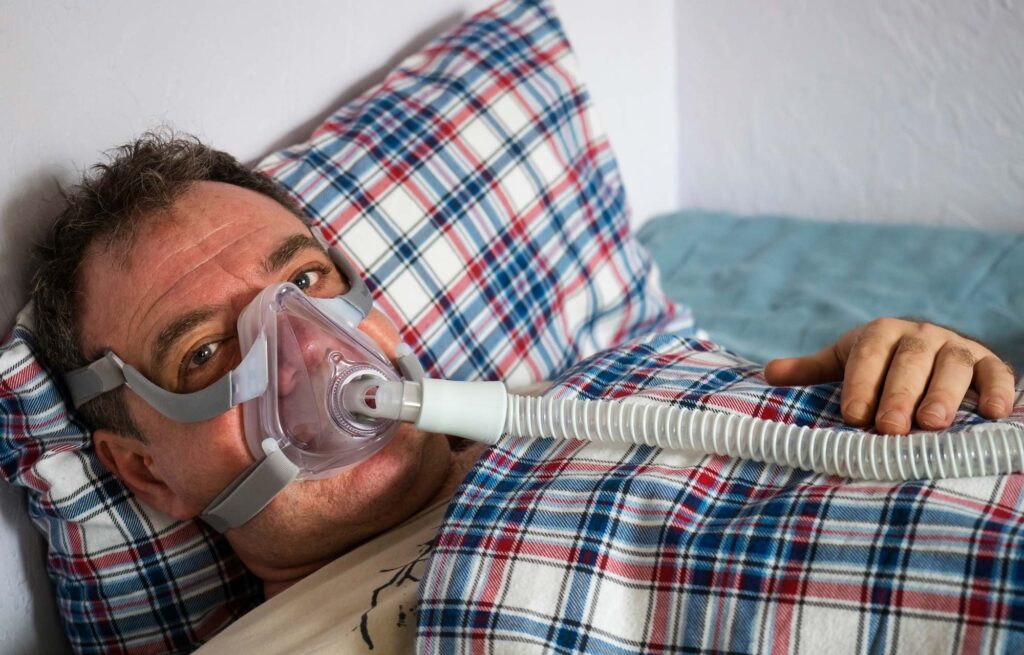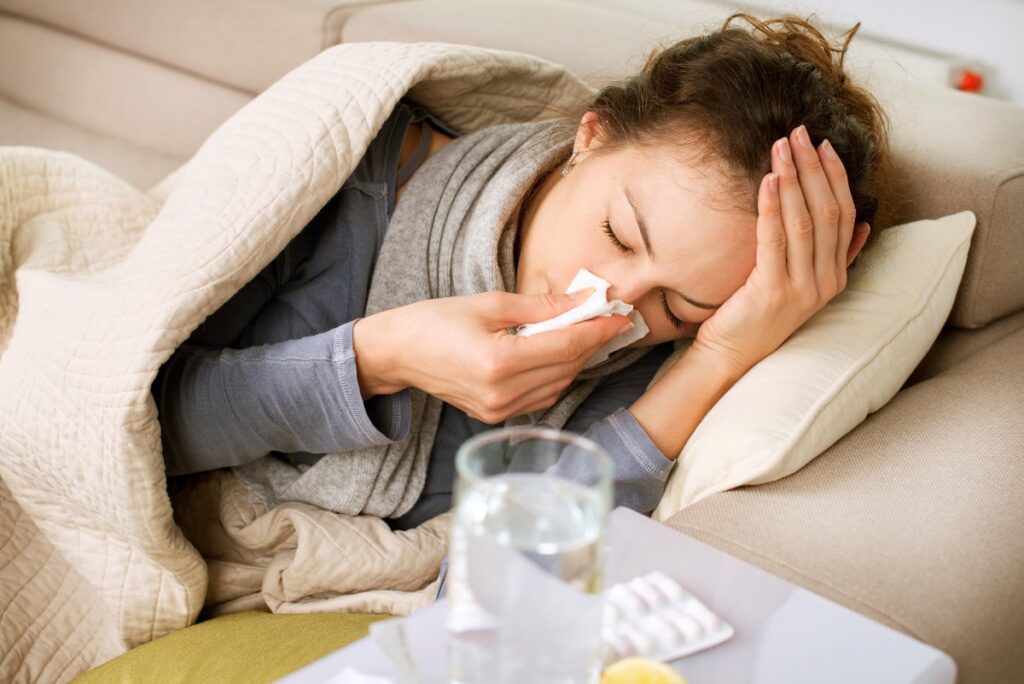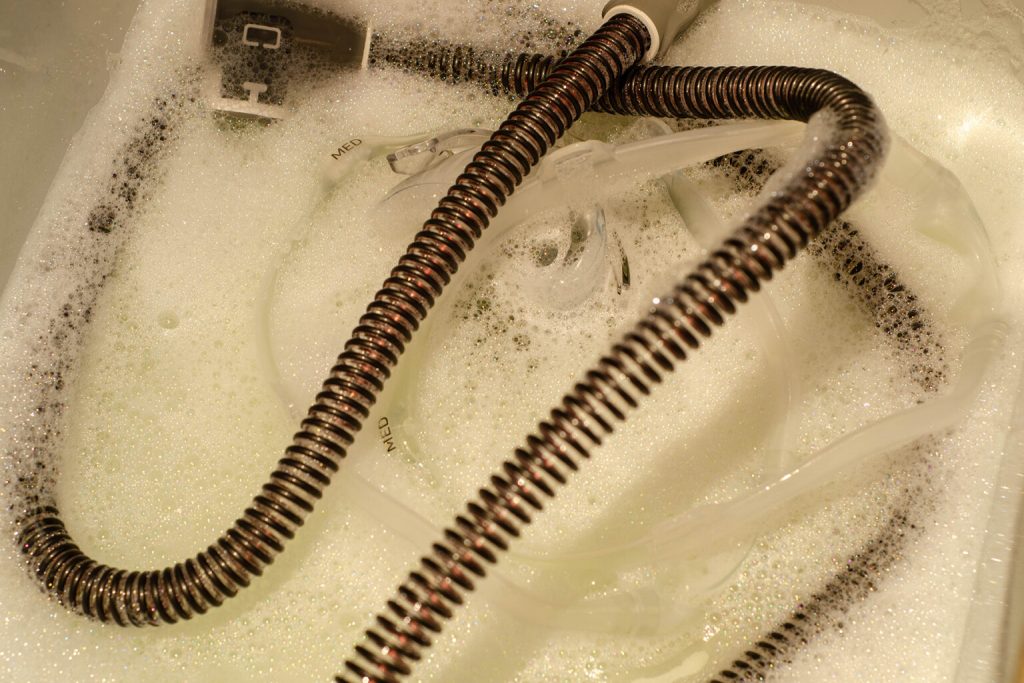Last Updated on August 24, 2021
You know it- you want to have a nice rest but alas! You are coughing endlessly, feeling stuffy, and sneezing endlessly! So, you’re not going to get the rest you deserve and crave after all-how frustrating! This also means you’re likely to stay sick for longer-owing to a lack of quality sleep.
But have you ever thought about it- did you know that your cold can develop into something worse if you use dirty equipment? Well, let’s dash in to discover the best ways to use your CPAP equipment while staying safe from pneumonia.
Should You Put Aside Your CPAP Machine When You Have a Cold?
It’s simple- note that your CPAP machine can’t function well if you’re dealing with a self-limiting respiratory problem that affects your breathing. Why? The CPAP machine is designed to supply you with a pressurized stream of air. This prevents airway obstruction in well-functioning lungs.
If you suffer from an upper respiratory infection (like influenza or common cold), you might find it more challenging to use your CPAP equipment. This is because your nose may be congested, runny, and stuffed up- just like what happens with allergies. Such a situation may cause breathing problems with your machine- particularly if you use a nasal mask.
Further, if you use nasal pillows, the mucus discharge can contaminate your CPAP mask. According to recent studies, you’ll face a secondary infection risk in such a situation, particularly if you allow microorganisms to multiply and breed on a contaminated mask.
In addition, when you suffer from coughing spells and a sore throat, the air flow might cause irritation. Every time you cough and open your mouth, it makes the incoming pressure even more uncomfortable.
Can Using a CPAP Worsen Your Cold Symptoms?
Of course, having cold symptoms can interfere with how you use your CPAP. When you have flu or cold, the symptoms can make it more challenging to use your CPAP machine.
For instance, when you have a congested, runny nose, you might find it harder to breathe. This is especially so if you use a nasal mask. This might cause you to breathe through the mouth, compromising the effectiveness of sleep apnea therapy. Further, having a sore throat usually leads to nighttime bouts of coughing. This can interfere with sleep.
Generally, cold and flu symptoms will often interfere with your CPAP therapy, preventing you from enjoying deep restorative sleep. In situations where you have problems using your CPAP, this can, undoubtedly, make everything worse.
Can You Get a Cold From Using Your CPAP?
Overall, whether or not they use a CPAP, most adults will probably suffer 2-4 bouts of colds per year. Experts believe that poor sleep weakens the response of one’s immune system to infections. Indeed, studies have linked poor sleep to increased vulnerability to some typical illnesses and colds.
Not surprisingly, many sleep apnea patients (who already suffer from poor sleep) may exhibit a weakened immune system. This further makes them vulnerable to ailments like colds and flu. CPAP may also worsen some minor cold symptoms and make it harder to sleep.
Overall, it’s essential to get quality rest. This prevents fights and helps you recover from colds. If you find that your CPAP therapy isn’t working in the expected way, this might suggest you’re not getting the right amount of sleep in order to keep the immune system in its top fighting form.
Hence, while there’s no direct evidence to suggest that that using CPAP equipment can cause you to have a cold, there’s a possibility it might cause a full-blown cold which might take a long time to heal.
Tips to Use a CPAP Equipment with a Cold
You can do several things to make it easier to use the CPAP equipment while having a cold. Consider the following tips:
Change your sleeping position:
Keep in mind that the congestion can get worse while you’re sleeping on your back. Elevate your head or sleep on your side. Use specific pillows designed for side sleepers wearing CPAP masks. Use more pillows to elevate the head (this allows the mucus to drain instead of stuffing you up).
Keep this in mind-sleeping on the side employs gravity to open the airway naturally. This means the CPAP machine will not have to work extra hard to open the airway; this also means a lower AHI. Hence, sleeping on your side can help you whenever you’re trying to use a CPAP with a cold.
Use a Heated Humidifier
Heated humidifiers are excellent for restoring the moisture levels to nasal passages and mucus membranes. This also relieves the discomfort that comes with a congested upper respiratory system.
Use a Nasal Spray and a Decongestant
There are many over-the-counter nasal sprays for clearing congestion arising from flu or common cold. Before using your CPAP machine, you can also use a saline nasal rinse to clear the nasal passages.
Keep this in mind: If you use over-the-counter nasal spray, make sure you consult your physician. This is particularly true if you have high blood pressure. Why? Some medications can cause health problems when combined with others.
Use an APAP Machine
A traditional CPAP machine delivers a singular therapeutic pressure-flow going through the respiratory system. The APAP (automatic positive airway pressure) machine, on the other hand, uses unique algorithms to deliver automatically regulated continuous pressure levels.
Keep in mind that when using the APAP machine, the device itself is designed to adjust the air pressure accordingly. This gives you the benefit of undisturbed sleep. Regardless, your demand for more or less pressure will depend on how well you are sleeping when you get sick. This makes the APAP the most suitable option.
Use a Full Face CPAP Mask
This is an excellent option since using a full-face CPAP mask will allow you to breathe through the mouth while asleep. Consult a sleep specialist before switching over from a nasal to a full face mask. Why? It might demand a higher pressure than what you’re ordinarily used to.
Prevent Sickness: Regularly Clean Your CPAP Mask
It’s always a great idea to use a CPAP cleaner to keep your CPAP equipment ever clean. You can keep away from possible infections by regularly cleaning your CPAP equipment. Germs usually form around your mask when you’re sick. Be cautious: You can be re-infected when you’re beginning to get better.
Whenever you’re sick, follow a regular cleaning schedule. Try to clean your mask once per day. This is particularly true if you’re using a nasal pillow mask. Why? Such a mask is always in contact with the nostrils. You prevent possible infections through regular cleaning of the CPAP. It’ll keep you healthier for a long time and make it easier to recover.
Final Thoughts
Undoubtedly, CPAP offers a fantastic treatment for sleep apnea. When sleep apnea gets worse, you should use it every night. Notably, some have found that using a CPAP when severely congested worsens their sleep pattern.
Of course, no one is happy having a cold during winter- or at any other time. When you put CPAP into the mix, things can get worse. But using the tips discussed here, you can enjoy great sleep at night and feel much better within a short time.



